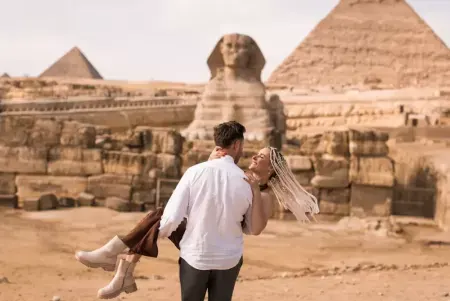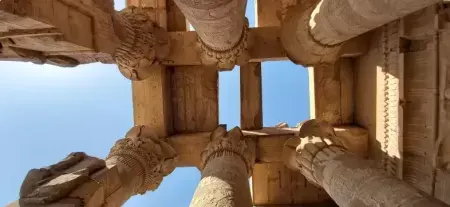Are you planning a trip to Egypt? If so, make sure to add the Kom Ombo Temple to your itinerary. This ancient temple, located in Aswan, is a must-visit destination for history buffs and archaeology enthusiasts. With its unique design, fascinating history, and impressive architecture, the Kom Ombo Temple is a testament to the rich cultural heritage of Egypt. In this blog post, we'll explore the secrets of the Kom Ombo Temple and all the fascinating facts that make it a true gem of ancient Egypt.
Introduction to Kom Ombo Temple
The Kom Ombo Temple is a double temple that was built during the Ptolemaic dynasty, around 180-47 BC. It is located on the east bank of the Nile River in the small town of Kom Ombo, about 30 miles north of Aswan. The temple is dedicated to two gods: Sobek, the crocodile god, and Horus, the falcon-headed god. The temple is unique in design, with two identical sections, one for each god. Each section has its own entrance, hypostyle hall, and sanctuary.
Where is Kom Ombo Located?
Kom Ombo is a small town located in Upper Egypt, approximately 45 kilometers north of the city of Aswan. The town sits on the east bank of the Nile River, with the temple of Kom Ombo located right on the river's edge. The temple is easily accessible by car, taxi, or boat, and visitors can enjoy stunning views of the Nile and surrounding desert landscape.
Who Built the Temple of Kom Ombo?
The temple of Kom Ombo was built during the Ptolemaic dynasty, which ruled Egypt from 305 BC to 30 BC. The temple was dedicated to two gods, Sobek and Horus, and was built on a site that had been sacred to these gods since ancient times. The temple was constructed over a period of several centuries, with different pharaohs and rulers adding their own contributions.
History of Kom Ombo Temple
The history of the Kom Ombo Temple dates back to the time of the Pharaohs. It is believed that the original temple was built during the reign of Ptolemy VI Philometor (180-145 BC), but most of the surviving structures were built during the reign of Ptolemy XIII Neos Dionysos (51-47 BC). The temple was built on the site of an older temple dedicated to the god Sobek, which was destroyed by the Nile flood.
The temple was an important religious center during the Ptolemaic and Roman periods. It was also a center of healing, with a hospital located nearby. The temple was also used for astronomical observations, and the walls of the temple are covered with astronomical scenes and hieroglyphs.
Significance of Kom Ombo Temple
The Kom Ombo Temple is significant for several reasons. It is one of the few double temples still standing in Egypt. It is also the only temple dedicated to the gods Sobek and Horus. The temple is also significant for its historical and cultural significance. The temple is a testament to the advanced engineering and architectural skills of the ancient Egyptians. It is also an important site for the study of ancient Egyptian religion and mythology.
Architecture of Kom Ombo Temple
The Kom Ombo Temple is a masterpiece of ancient Egyptian architecture. The temple is designed in a symmetrical fashion, with two identical sections, one for each god. The temple is built of sandstone and has a series of halls and chambers, including a hypostyle hall, a vestibule, and a sanctuary. The walls of the temple are covered with hieroglyphs, scenes from ancient Egyptian mythology, and astronomical scenes.
The temple also has a number of unique features, including a Nilometer, which was used to measure the level of the Nile River, and a crocodile museum, which houses the mummified remains of crocodiles that were once worshipped in the temple.
Fascinating Facts about Kom Ombo Temple
There are many fascinating facts about the Kom Ombo Temple. For example, the temple was built on the site of an older temple dedicated to the god Sobek, which was destroyed by the Nile flood. The temple is also the only temple in Egypt dedicated to the gods Sobek and Horus. The temple was also an important center of healing during the Ptolemaic and Roman periods, with a hospital located nearby. The walls of the temple are covered with astronomical scenes and hieroglyphs, making it an important site for the study of ancient Egyptian astronomy.
The Kom Ombo Temple Complex
The Kom Ombo Temple is not just a single temple, but a complex of temples, chapels, and other buildings. The temple complex includes the main temple dedicated to Sobek and Horus, as well as a number of other temples dedicated to other gods and goddesses, such as Isis and Anubis.
The temple complex also includes a number of other buildings, such as a hospital, a Nilometer, and a crocodile museum. The complex is surrounded by a wall, and there are a number of courtyards and gardens within the complex.
Mythology Associated with Kom Ombo Temple
The Kom Ombo Temple is associated with several myths and legends from ancient Egyptian mythology. One of the most famous stories is the legend of Horus and Set. According to the legend, Horus and Set were two brothers who battled for control of Egypt. Set killed Horus and cut his body into pieces, but Horus was eventually resurrected by his mother, Isis. The temple is also associated with the god Sobek, who was worshipped as the god of the Nile and the protector of fertility.
Why Was the Temple of Kom Ombo Built?
The temple of Kom Ombo was built to honor the gods Sobek and Horus, who were both important deities in ancient Egyptian religion. Sobek was the crocodile god, revered for his strength and power, while Horus was the god of the sky and kingship. The temple was also believed to have healing powers, and many people came to the temple seeking cures for their ailments.
The temple was also an important center of commerce and trade, as it was located on a major trade route that connected Upper Egypt with Nubia and the Red Sea. Merchants and traders would often stop at the temple to offer gifts and prayers to the gods, and to seek their protection and blessings for their journeys.
The Discovery and Restoration of Kom Ombo Temple
The Kom Ombo Temple was rediscovered in the 19th century by French archaeologist Auguste Mariette. The temple was in a state of disrepair, and much of the temple had been destroyed by the Nile flood. Mariette began the process of restoring the temple, but it was not until the 1960s that the temple was fully restored.
Today, the temple is one of the most important archaeological sites in Egypt. It is a UNESCO World Heritage Site and is visited by thousands of tourists every year.
Visiting Kom Ombo Temple - Tips and Guidelines
If you are planning a visit to the Kom Ombo Temple, there are a few things you should keep in mind. The temple is located in the small town of Kom Ombo, about 30 miles north of Aswan. The temple is open to visitors every day from 8 am to 5 pm. It is recommended that you visit the temple early in the morning or late in the afternoon to avoid the crowds.
When visiting the temple, it is important to respect the rules and regulations. Do not touch or climb on the ancient structures, and do not take any souvenirs from the site.
Kom Ombo Temple Surroundings
The temple of Kom Ombo is surrounded by several other interesting sites to explore in the area around Kom Ombo. One of the most popular is the temple of Edfu, which is located approximately 50 kilometers to the north. This temple is dedicated to the god Horus and is one of the best-preserved ancient temples in Egypt.
Temple of Kom Ombo Tickets Price and Opening Hours
If you're planning a visit to the temple of Kom Ombo, you'll be pleased to know that it is open daily from 9:00 AM to 5:00 PM. The entrance fee for the temple is 140 Egyptian pounds per person (as of 2021), and this includes access to the temple complex and the museum. Visitors can also purchase a combined ticket that includes entry to other nearby sites, such as the temple of Edfu and the Nubian Museum.
Conclusion
The Kom Ombo Temple is a true gem of ancient Egypt. With its unique design, impressive architecture, and fascinating history, the temple is a testament to the rich cultural heritage of Egypt. Whether you are a history buff or an archaeology enthusiast, a visit to the Kom Ombo Temple is a must. So, add it to your itinerary and discover the secrets of this iconic temple for yourself!
Browse our Egypt Vacations and visit the Temple of Kom Ombo











.jpg)



